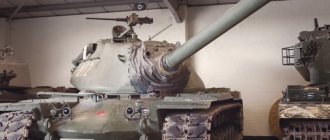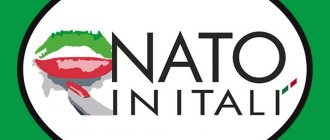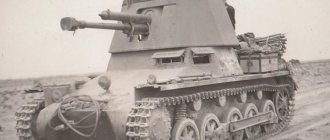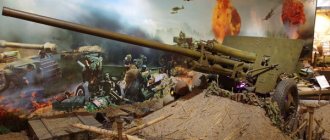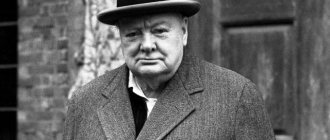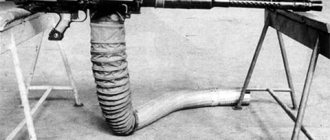One of the few color photographs from the Korean War
As a result of the Second World War, new “centers of power” established themselves on the planet, various forms of their interactions began to take shape, and often this led to an increase in contradictions, their aggravation to extreme conflict situations. One of the most striking examples of this kind is the causes, course and results of the Korean War, which lasted from 1950 to 1953.
Outwardly, this conflict looked like a local armed clash between two state associations that had formed in the northern and southern parts of the Korean Peninsula. But in essence, this became a manifestation of an open confrontation between two blocs that had already formed by that time: the eastern one, led by the Soviet Union, and the western one, under the auspices of the United States.
Background
From 1910 to 1945, Korea (formerly the kingdom of Goryeo) was a Japanese colony. After Japan's defeat in World War II, by agreement between the allies, it was divided into two occupation zones - Soviet (north of the 38th parallel) and American (south of it). The aggravation of the Cold War prevented the USSR and the USA from reaching a compromise agreement on ways to build a unified Korean state. On May 10, 1948, under the supervision of a UN commission, elections to the National Assembly were held in the southern zone, which on August 15 announced the creation of the Republic of Korea (ROC). Syngman Rhee (1948–1960) became the country's president, establishing an authoritarian pro-American regime. In response, the USSR-oriented government of the northern zone (the People's Committee of North Korea), headed by Kim Il Sung, held elections to the Grand People's Assembly in July 1948, which in early September proclaimed the creation of the Democratic People's Republic of Korea (DPRK). A communist regime was established in the north.
Also on topic:
DEMOCRATIC PEOPLE'S REPUBLIC OF KOREA (DPRK) (NORTH KOREA)
After the USSR and the USA withdrew their troops from the peninsula, the leaders of North and South Korea began to develop plans to unify the country by military means. The DPRK, with the help of the USSR, and the Kyrgyz Republic, with the help of the United States, formed their own armed forces. In this competition, the DPRK was ahead of South Korea: the Korean People's Army (KPA) was superior to the Army of the Korean Republic (AKR) in numbers (130 thousand versus 98 thousand), in the quality of weapons (high-quality Soviet military equipment) and in combat experience (more than a third of North Korean soldiers participated in the Chinese Civil War). However, neither Moscow nor Washington were interested in the emergence of a hotbed of tension on the Korean Peninsula - they preferred to limit the scope of the Cold War to the European continent, not wanting it to spread to the Far East, which was fraught with an increase in the risk of a nuclear conflict. However, this prospect especially worried the Chinese communists, who in 1949 achieved decisive successes in the Civil War with the regime of Chiang Kai-shek and were preparing to liquidate its last bastion - Taiwan; they feared that an armed conflict in Korea would provoke an American invasion of Asia and thereby interfere with their plans for Taiwan.
On January 12, 1950, US Secretary of State D. Acheson made a statement that the perimeter of American defense in the Pacific region included the Philippines, the Ryukyu Islands, Japan and the Aleutian Islands; the statement said nothing about South Korea. The North Korean and Soviet leadership was under the impression that in the event of a war between the DPRK and the Kyrgyz Republic (if the USSR and the PRC did not participate in it), the United States would remain neutral. It was with the help of this argument that Kim Il Sung, as recently opened documents from the Soviet archives show, was able to convince J.V. Stalin to approve his plan to invade the south.
South zone
The end of Japanese rule caused political turmoil among Koreans in both zones. Various political parties emerged in the south. Although they were roughly divided into right, left and middle, they had a common goal: the immediate achievement of self-government. As early as August 16, 1945, some Koreans organized the Committee for the Preparation of Korean Independence, headed by Un-Hyun Lyuh, which was closely associated with the left. On September 6, delegates attending the "National Assembly" convened by the committee proclaimed the People's Republic of Korea.
But the American military government refused to recognize the Republic, claiming that the military government was the "sole government" in Korea, as stipulated in General Order No. 1. The exiled Korean Provisional Government, upon returning, was also forced to declare itself a political party. US policy in Korea was establishing a trusteeship that would replace both American and Soviet occupation forces in Korea. At the end of December, the Council of Foreign Ministers (representing the United States, the Soviet Union and Great Britain) met in Moscow and decided to create a quadripartite trusteeship for a period of up to five years. Upon receiving this news, the Koreans reacted violently. In February 1946, to calm discontent, the military government created a representative Democratic Council as an advisory body to the military government. This body was composed of Koreans and its chairman was Syngman Rhee, the former president of the Korean government in exile. In October, the military government created a provisional Legislative Assembly, half of whose members were elected by the people and half appointed by the military government. The Assembly was empowered to make decisions on internal affairs, but had veto power from the military government. The protest against guardianship reached its climax a few months later when the assembly condemned guardianship in Korea.
Battle of Busan Perimeter (August 4 – September 14, 1950)
At the end of July 1950, the Americans and South Koreans retreated to the southeastern corner of the Korean Peninsula in the area of the port of Busan (Busan Perimeter), organizing defense along the Jinju - Daegu - Pohang line. On August 4, the KPA began an assault on the Pusan Perimeter. By this time, the number of defenders, thanks to significant American reinforcements, had reached 180 thousand, they had 600 tanks at their disposal, and they occupied advantageous positions on the river. Naktong and in the foothills. Nevertheless, the attackers, with much smaller forces (98 thousand and 100 tanks), during the First Battle of Naktong (August 8–18) managed to capture Jinju and come close to the port of Masan. At the same time, American and South Korean troops managed to stop the North Korean offensive west of Daegu on August 15–20 (“Battle of Bowling”). On August 24, 7.5 thousand North Koreans with 25 tanks almost broke through the American defenses near Masan, which was defended by 20 thousand soldiers with 100 tanks. Nevertheless, the American forces were constantly increasing, and from August 29, units from other countries, primarily the British Commonwealth, began to arrive near Busan. On September 1, KPA troops launched a general offensive and on September 5–6, they made a hole in the South Korean defensive lines in the northern section of the perimeter at Yongchon, took Pohang and reached the immediate approaches to Daegu. Only thanks to the stubborn resistance of the American Marines (1st Division) was the offensive stopped by mid-September (Second Battle of Naktong).
When did people appear on the Korean Peninsula?
Approximately 5 thousand years BC. And in 1300 BC. e. The first Korean state, Ancient Joseon, was formed, which existed until 108 BC, until it was conquered by the Chinese Han Empire.
In 935, the state of Koryo was formed on the peninsula - the prototype of the name “Korea”. It existed until 1259, the period of the conquest of the peninsula by the Mongol Empire.
From 1636 until the end of the 19th century, Korea was formally under Chinese rule, and from 1910 to 1945 under Japanese occupation.
"Ridgway's Counter-Offensive" (January 25 – April 21, 1951)
At the end of January - end of April 1951, Ridgway launched a series of attacks with the goal of recapturing Seoul and pushing the Chinese and North Koreans back beyond the 38th parallel. During Operation Thunderbolt, which began on January 25, 1951, the 8th Army captured Suwon on January 26, and Inchon on February 10. On February 5, the 10th Corps also launched an offensive; True, on February 11–12, as a result of a Chinese counterattack, he was thrown back to Wonju, but a week later he still forced the enemy to retreat to Hengson. On February 21, the 8th Army launched a new attack in the north (Operation Killer) and by February 28 reached the lower reaches of the Han River on the closest approaches to Seoul. On March 7, the Allies launched another offensive (Operation Ripper), occupied Seoul on March 14–15, and by March 31 reached the “Idaho Line” (lower Imjingan - Hongchon - north of Chumunjin) in the area of 38 parallel. On April 2–5, they made a breakthrough in the central direction and by April 9 reached the Hwacheon reservoir (Operation Ragid), and by April 21 they were already on the closest approaches to Chorwon, displacing the PLA and KPA beyond the 38th parallel (with the exception of the extreme western section front).
Even before the completion of the counteroffensive, MacArthur, due to disagreements with Truman regarding the idea of using nuclear weapons in the Korean War against PLA and KPA forces and for mistakes made in November 1950, was removed from his post as commander of the UN forces and replaced by Ridgway (April 11). General D. Van Fleet became the commander of the 8th Army (April 14).
The main signs of totalitarianism
Thus, we can now outline in general terms the main features of totalitarianism inherent in the North Korean regime:
- ideology obligatory for all;
- Cult of personality;
- censorship;
- one-party system;
- Planned Economy;
- developed propaganda;
- the exclusive role of the state in all public affairs;
- powerful repressive coercive apparatus.
This is how modern North Korea appears before us. The political regime is totalitarian communism with an admixture of nationalism. This characterization of the existing system will be the most accurate. In addition, the North Korean regime is characterized by a hereditary change of power and extreme closeness in relations with other countries of the world. The level of confrontation with the United States of America is intensifying.
Unfortunately, no significant changes in the political system of the DPRK are expected in the near future.
Battle of the 38th parallel (April 22 – July 10, 1951)
From late April to early July 1951, the warring parties made a number of attempts to break through the front line and change the situation in their favor. On April 22, Chinese and North Korean troops (350 thousand) attacked the 8th Army in the western direction, again throwing it back beyond the 38th parallel, but at the end of April they were stopped north of Seoul and at Hongchon. On May 15, they launched a strike in the central and eastern directions, but it was not successful either. On May 21, the 8th Army launched a counteroffensive, by the end of May it drove Chinese and North Korean troops back beyond the 38th parallel, but in June it became bogged down in battles for the “Iron Triangle” (a strategically important area between the cities of Chorwon, Pyongan and Kimhwa). True, in mid-June she managed to capture Chorwon, but then military operations acquired a positional character.
"Communist Monarchy"
North Korea developed in such an ideological atmosphere. Due to the change of rulers within the same family, some experts call the political system that was formed in the DPRK a “communist monarchy.” Of course, not everyone agrees with this opinion, since after all, the leader is chosen by the party, and he theoretically could belong to another family. Other experts, due to the significant focus of the Korean version of Marxism on national characteristics, call the political regime of North Korea communist nationalism or national communism.
Air war
An important part of the Korean War was the confrontation in the skies. It was the last major military conflict to use propeller-driven fighters, and the first to use jet fighters. In the initial phase of the war, the KPA, thanks to the presence of Yakov, had complete air superiority. But with the intervention of the Americans in the conflict, whose air force had F-80 fighters (“shooting stars”) with a turboprop jet engine, the situation changed dramatically: during the defense of the Busan perimeter, the landing at Inchon and the invasion of UN troops into North Korea, aviation dominated the skies Western coalition. Bombers B-29 (“flying fortresses”) and B-26, operating under the cover of “shooting stars,” served as long-range artillery, clearing the way for advancing troops and destroying enemy communications.
Then, during the first period of the Chinese offensive (November 1950), new Soviet jet fighters MiG-15 appeared in the Korean skies, which significantly surpassed the F-80 in their technical characteristics; Soviet officers had extensive combat experience since the Great Patriotic War. In a series of air battles from November 1950 to January 1952 between Pyongyang and the Yalu River (“MiG Alley”), Soviet pilots inflicted serious damage on the aviation of the Western allies, shooting down 564 aircraft and losing only 71 aircraft and 34 pilots. The connection between the enemy's bombers and fighters was destroyed - without air support he could no longer carry out large-scale ground offensive operations.
From the end of 1951, the Americans began to use a new type of jet fighter - the F-86 (“saber”), which in terms of ferry range, maximum speed, rate of climb and operational ceiling approached the MiG-15. As a result, they were able to reduce the loss ratio from 8:1 to 2:1. During 1952, the 64th Corps shot down 394 aircraft, losing 174 (51 pilots), in the first half of 1953 - 139 aircraft, losing 76 (25 pilots). If ground operations virtually ceased at the beginning of 1953, the activity of air confrontation remained high until the very end of the war.
Over the entire period of participation in hostilities, Soviet pilots flew 63,229 sorties and conducted 1,790 air battles, shooting down 1,097 enemy aircraft. The total losses of the 64th Corps were 319 vehicles and 110 pilots.
Is there private property?
No. In the DPRK, everything is state-owned, but since 1998, private ownership of residential real estate has been allowed. The famine in the 90s, no matter how cynical it may sound, had a beneficial effect on the market. At first, the North Koreans began planting forbidden vegetable gardens and engaging in smuggling, then private retail trade, restaurants, workshops, and hotels appeared. Now private lending structures are developing. Although there are no commercial banks in North Korea, the state turns a blind eye to this. According to defectors, loans for the purchase of seeds and fertilizers are popular among North Koreans - lenders receive interest with rights to part of the future harvest.
Despite private trade, North Korea is one of the poorest countries in the world. Ranks 213 out of 230 in GDP per capita: $1,700 per year. Economists see the reasons for poverty in the fact that the state is closed from the world and spends too much on the army.
For comparison, in South Korea, GDP per capita is 39.4 thousand dollars. The country ranks 12th in the world.
Peace talks and truce in Panmunjom
The stalemate that developed in the summer of 1951 on the Korean front prompted the participants in the conflict to search for diplomatic ways to resolve it. On June 23, the Soviet representative to the UN called for a ceasefire in Korea. In response, Ridgway on June 30 invited the DPRK and the PRC to enter into negotiations. Negotiations between the command of the KPA and the PLA, on the one hand, and the command of the UN forces, on the other, opened on July 10 in Kaesong (North Korea), but were interrupted on August 23 by the North Korean delegation. However, after another successful local offensive by the 8th Army in the Chorwon area (October 3–19), the DPRK resumed negotiations (October 25), which were moved to Panmunjom. On November 12, the American command decided to finally abandon offensive actions and switch to “active defense.”
On November 27, 1951, the parties agreed to establish a demarcation line based on the existing front line and to create a demilitarized zone. But then the negotiations stalled due to disagreements on the issue of the repatriation of prisoners of war: the DPRK demanded their mandatory return, while UN representatives insisted on the principle of voluntariness. On October 8, 1952, the UN delegation interrupted the negotiations due to lack of progress. On October 24, during the presidential election campaign in the United States, Republican candidate D. Eisenhower, given the deep dissatisfaction of Americans with the protracted war, promised, if elected, to go to Korea and establish peace there, which largely ensured his victory in the elections on November 4. On November 29, the newly elected president visited Korea.
On March 28, 1953, the DPRK proposed resuming negotiations and exchanging sick and wounded prisoners of war even before the signing of the armistice. Despite the objections of Secretary of State D.F. Dulles, who demanded North Korea's consent to the political unification of Korea as a precondition, the Eisenhower administration returned to the negotiating table on April 26. On June 8, the DPRK government, under pressure from Chinese diplomacy, agreed to the voluntary repatriation of prisoners of war on the condition that it would occur under the supervision of both sides. However, the South Korean parliament unanimously rejected this option; Syngman Rhee urged Eisenhower to “continue the fight for the unification of the country.” These calls met a wide response in the US Congress, especially among the ruling Republican Party. Nevertheless, the American president was able to convince the South Korean leadership to support the truce project.
On July 27, 1953, at 10 a.m. in Panmunjom, American Lieutenant General W. Harrison from the UN command in Korea and North Korean General Nam Il from the command of the KPA and Chinese troops signed an armistice, according to which 12 hours after the act of signing all military operations on the peninsula ceased . A 4-kilometer demilitarized zone was created between South and North Korea, running from the mouth of Imjingan in the west through the northern outskirts of Chorwon to the coast of the Sea of Japan in the east. To monitor compliance with the terms of the truce, the Military Commission for the Armistice in Korea was established, consisting of ten senior officers (five from the UN troops and five from the PLA and KPA) and the Commission of Neutral Countries for Supervising the Armistice in Korea, consisting of four military representatives from Poland, Czechoslovakia, and Switzerland. and Sweden. The Korean War is over.
Atmosphere of terror
Another distinctive feature of the North Korean political system is state terror against all dissidents or simply unwanted people. Its scale has not yet been fully disclosed, since the DPRK is an almost completely closed country. But, despite this, the world has already learned about hundreds of thousands of repressed people.
According to unconfirmed reports, Kim Jong-un ordered the execution of the Minister of Defense simply because he fell asleep at a meeting. Moreover, the method of execution chosen was very sophisticated: the minister was shot from an anti-aircraft system. Kim Jong-un personally burned another minister with a flamethrower. In addition, by order of the young Korean leader, his uncle was executed along with his entire family, including young children.
But this is only a small fraction of the horrors of repression that North Korea keeps secret. The country's political structure is, of course, maintained through the use of state terror, which was especially brutal under Kim Jong-un.
Losses
The war left a huge number of victims on both sides. The total military losses of the South Koreans are estimated at 984.4 thousand (228 thousand killed). According to American data, the North Koreans lost approx. 600 thousand, and the Chinese - approx. 900 thousand. The Chinese estimate their total military losses at 460.6 thousand (including 145 thousand killed).
The total losses of the UN forces amounted to 118.5 thousand killed, 264.5 thousand wounded and 93 thousand prisoners. The Americans suffered the largest losses - 169 thousand (irrecoverable - 54 thousand, including 33.6 thousand killed in battle); this figure is only slightly lower than the number of their losses in the Vietnam War of 1964-1973. The total losses of the remaining coalition members are as follows: Great Britain - 5017 (710 killed), Turkey - 3349 (717), Australia - 1591 (291), Canada - 1396 (309), France - 1135 (288), Thailand - 913 (114), Greece – 715 (169), Netherlands – 704 (111), Colombia – 686 (140), Ethiopia – 656 (120), Philippines – 488 (92), Belgium and Luxembourg – 453 (97), New Zealand – 115 (34 ), South African Republic – 42 (20).
According to various estimates, the losses of the civilian population of Korea are estimated at 3 million. More than 80% of Korean production potential and vehicles were destroyed. The bombings caused enormous damage: for example, UN aviation practically wiped out Pyongyang, which was home to approx. 400 thousand people The result of the conflict was a real humanitarian catastrophe on the peninsula.

